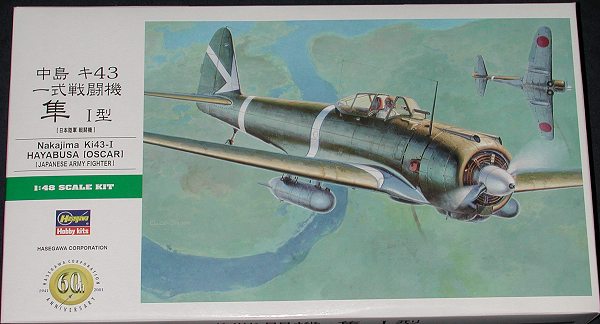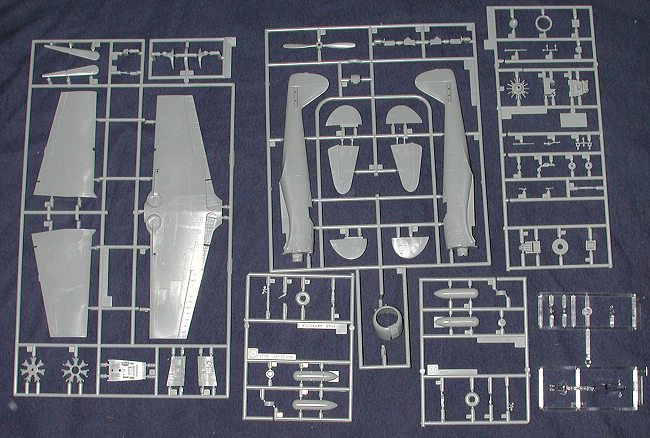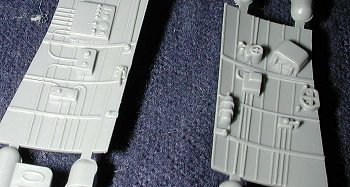
|
KIT: |
Hasegawa 1/48 Ki-43-I Hayabusa |
|
KIT # |
9080 (JT 80) |
|
PRICE: |
$24.00 |
|
DECALS: |
Two aircraft |
|
REVIEW & |
|
|
NOTES: |
` |

|
HISTORY |
The Ki-43 Hayabusa was the Japanese Army Air Forces' equivalent of the Navy's A6M Zero. It as the first fighter with retractable landing gear in the service and was built with maneuverability and range as its main requirements. Its armament was pathetic with twin 7.7mm machine guns and it had almost no armor protection for either the pilot or fuel systems. Against an inferior enemy, like the Chinese, the plane was a terror. Against a better equipped adversary, it didn't fare quite as well.
The initial aircraft were in squadron service when the Pacific war broke out and they were quickly sent to Southeast Asia where they participated in the fight against the Allies in Burma and southern China. They were also found in the Dutch East Indies and New Guinea. While they were quite successful against Allied aircraft and their inexperienced pilots, by mid 1943 when better planes were available for the Allies, the Ki-43 began to show its deficiencies.
However, many JAAF aces flew the Ki-43 and it was modified throughout the war, though it never was able to reach parity with Allied types. It was decided to code name these planes in the 1942/43 time period as most Allied pilots didn't know what Japanese planes were called. Interestingly, all these planes were given 'hill-billy' US names like Zeke, Claude, Topsy, Pete and so forth. Never a Tom. or John, or David. The Ki-43 was code named Oscar, though throughout the war, like most Japanese fighters, it was simply referred to as a Zero!
|
THE KIT |

It really comes as no surprise that Hasegawa would release this kit. They were the folks who pressed the Fine Molds Oscar models and though this kit has no relationship to the others besides the fact that Hasegawa's molding machines were used, there are a number of similarities between the kits.
The first thing you see is that the wing tips are separate. This is to allow the later model Ki-43s with their longer wings to be done using one sprue for the wings. This means that the tips of the ailerons will have to be filled and sanded as the tips cut through them. I would seem to me that offering separate ailerons would have eliminated this need, but Hasegawa chose this method.
 Like the Ki-84 and new mold A6M,
the detailing is just superb. While I'm sure that there will be aftermarket sets
for the kit, it really isn't needed. Unlike the Ki-84, you don't have a lot of
separate knobs and buttons in the cockpit. I recall that there were as many as
15-20 parts to the Frank cockpit and this one only has 9 and that includes the
sidewalls.
Like the Ki-84 and new mold A6M,
the detailing is just superb. While I'm sure that there will be aftermarket sets
for the kit, it really isn't needed. Unlike the Ki-84, you don't have a lot of
separate knobs and buttons in the cockpit. I recall that there were as many as
15-20 parts to the Frank cockpit and this one only has 9 and that includes the
sidewalls.
Thankfully, the only 'plug ins' are the prop and the tail wheel. This makes for a much sturdier construction. The aft part of the prop spinner is an interesting construct as it comes in two parts, trapping the prop between them. The forward part is a separate piece. This should help with painting if you have a two color spinner.
The tires are already flattened and not bulged. You also get a pair of drop tanks should you wish them. The canopy can be displayed open, which is quite nice. Also separate are the underfuselage 'butterfly' maneuvering flaps. These slid back to increase the area of the wing and therefore increase maneuverability. However, I must mention that looking at several dozen images of Oscars on the ground, I did not once see these deployed.
 Instructions are typically
excellent and give Gunze Paint matches. There are decals for two aircraft. To
the surprise of no one who models Japanese planes, there are markings for Tateo
Kato of the 64th Sentai in Burma during spring of 1942. This aircraft has lots
of white arrows and stripes on it. You get the markings as single or two-piece
striping except for the tail arrow. I guess you can paint the white part if you
choose. The other plane is for 1 sentai commander Maj. Kinshiro Takeda, in late
1942. Both planes are in Nakajima green upper with Kato's plane having a
green-grey underside and Takeda's in unpainted aluminum. Neither have the yellow
IFF wing bands, but Takeda's has a yellow rudder and elevators. It only shows
the yellow on the top of the elevators. Perhaps an Oscar enthusiast can give
more information on this. I would also think that the control surfaces on the
underside of Takeda's plane would be in the grey green color as well.
Instructions are typically
excellent and give Gunze Paint matches. There are decals for two aircraft. To
the surprise of no one who models Japanese planes, there are markings for Tateo
Kato of the 64th Sentai in Burma during spring of 1942. This aircraft has lots
of white arrows and stripes on it. You get the markings as single or two-piece
striping except for the tail arrow. I guess you can paint the white part if you
choose. The other plane is for 1 sentai commander Maj. Kinshiro Takeda, in late
1942. Both planes are in Nakajima green upper with Kato's plane having a
green-grey underside and Takeda's in unpainted aluminum. Neither have the yellow
IFF wing bands, but Takeda's has a yellow rudder and elevators. It only shows
the yellow on the top of the elevators. Perhaps an Oscar enthusiast can give
more information on this. I would also think that the control surfaces on the
underside of Takeda's plane would be in the grey green color as well.
No matter how you look at it. This is a great looking kit. It should also be pretty much of a 'slammer' as it does not have a lot of parts to it. I'm sure the aftermarket boys are even now cranking out stuff for this kit. Guess you can give away your Nichimo -Is as this one is now the top dog!
Review kit courtesy of me and my wallet!
If you would like your product reviewed fairly and quickly by a site that averages thousands of visits a day, please contact me or see other details in the Note to Contributors.